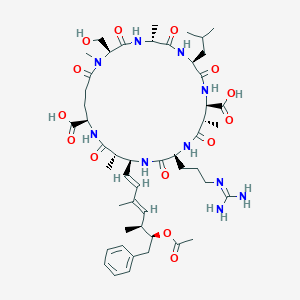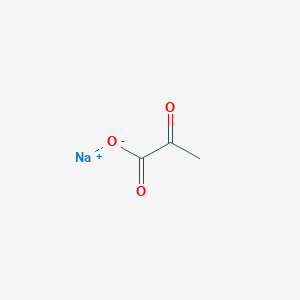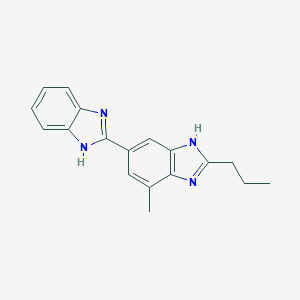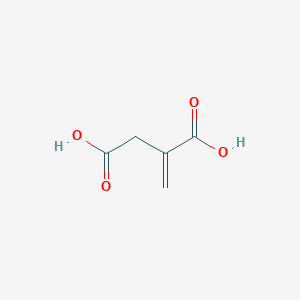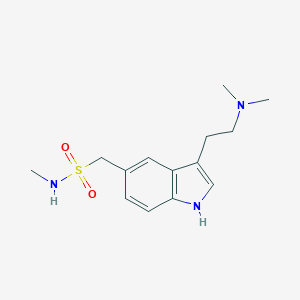
Sumatriptan
Vue d'ensemble
Description
Mécanisme D'action
Target of Action
Sumatriptan is a serotonin receptor agonist . Its primary targets are the 5-HT1B and 5-HT1D receptors . These receptors play a crucial role in the transmission of pain signals in the brain and are involved in the regulation of mood, appetite, and sleep .
Mode of Action
This compound binds with high affinity to the 5-HT1B and 5-HT1D receptors . This binding leads to the constriction of cranial blood vessels and inhibits the release of pro-inflammatory neuropeptides . The constriction of blood vessels can help to alleviate the pain associated with migraines and cluster headaches .
Biochemical Pathways
The biochemical pathways affected by this compound primarily involve the serotonin (5-HT) system . By acting as an agonist at the 5-HT1B and 5-HT1D receptors, this compound can influence the serotonin system and subsequently affect various downstream effects related to pain perception . Additionally, it has been found that this compound can increase the expression of endothelial nitric oxide synthase (eNOS), which can lead to an increase in nitric oxide metabolites .
Pharmacokinetics
This compound has a bioavailability of 15% when taken orally and 96% when administered by subcutaneous injection . It is predominantly metabolized by monoamine oxidase A (MAO A) . The elimination half-life of this compound is approximately 2.5 hours , and it is excreted through urine (60%) and feces (40%) .
Result of Action
The primary result of this compound’s action is the relief of migraine and cluster headaches . It achieves this by constricting cranial blood vessels, inhibiting the release of pro-inflammatory neuropeptides, and blocking pain signals from being sent to the brain . This leads to a decrease in the intensity of the headache and other associated symptoms .
Action Environment
The action of this compound can be influenced by various environmental factors. For instance, the drug’s efficacy can be affected by the timing of administration, with the drug being most effective when taken early after the onset of pain . Additionally, factors such as the patient’s overall health status, age, and other individual characteristics can also influence the drug’s action, efficacy, and stability .
Applications De Recherche Scientifique
Sumatriptan has a wide range of scientific research applications:
Chemistry: Used as a model compound in the study of triptan synthesis and reaction mechanisms.
Biology: Investigated for its effects on serotonin receptors and its role in neurotransmission.
Medicine: Extensively used in clinical trials for migraine and cluster headache treatments. It is also studied for its potential use in other neurological disorders.
Industry: Employed in the pharmaceutical industry for the development of migraine medications and related therapeutic agents
Analyse Biochimique
Biochemical Properties
Sumatriptan is an agonist of 5-HT 1B and 5-HT 1D . This agonism leads to constriction of cranial blood vessels and inhibits the release of pro-inflammatory neuropeptides . This compound decreases carotid arterial blood flow, but increases blood flow velocity in the internal carotid artery and middle cerebral artery .
Cellular Effects
This compound works in the brain to relieve the pain from migraine headaches . It belongs to the group of medicines called triptans . Many people find that their headaches go away completely after they take this compound . This compound has caused serious side effects in some people, especially people who have heart or blood vessel disease .
Molecular Mechanism
This compound reduces neurotransmitter release by inhibiting glutamatergic synaptic transmission . The increased levels of glutamine could arise in an effort to balance the glutamatergic system . This compound’s primary therapeutic effect is related to its inhibition of the release of Calcitonin gene-related peptide (CGRP), likely through its 5-HT 1D/1B receptor-agonist action .
Temporal Effects in Laboratory Settings
The strongest evidence and most favorable outcomes are reported for subcutaneous this compound, rizatriptan orally disintegrating tablets (Maxalt Mlt), zolmitriptan orally disintegrating tablets .
Dosage Effects in Animal Models
This compound improved the integrity of intestinal mucosa after I/R, and 0.1 mg/kg was the most effective dose of this compound in this study . This compound decreased the increased levels of TNF-α, kynurenine, and p-ERK but did not change the decreased levels of NO .
Metabolic Pathways
This compound is predominantly metabolized by monoamine oxidase A . The main metabolites are the inactive indole acetic acid and indole acetic acid glucuronide .
Transport and Distribution
This compound has a volume of distribution of 50±8L for a 6mg subcutaneous dose , or 2.7L/kg . This compound is 14%-21% bound to protein in circulation .
Subcellular Localization
Given its mechanism of action, it is likely that this compound primarily acts at the cell surface, where it interacts with 5-HT 1B and 5-HT 1D receptors
Méthodes De Préparation
Synthetic Routes and Reaction Conditions: The preparation of Sumatriptan involves several key steps:
Nitro Reduction Reaction: A compound is reduced under the action of a palladium on carbon-ammonium formate or palladium on carbon-formic acid system to obtain an intermediate compound.
Bromination Reaction: The intermediate compound undergoes bromination with N-bromosuccinimide.
Acylation Reaction: The brominated compound is acylated with an acylating agent.
Condensation Reaction: The acylated compound is condensed with 4-dimethylamino-2-butylene-1-ol.
Intramolecular Coupling Reaction: Catalytic cyclization forms the indole ring, and the protection group is removed in a basic system to yield this compound.
Industrial Production Methods: Industrial production of this compound often involves similar synthetic routes but optimized for large-scale production. This includes the use of phase transfer catalysts and specific reaction conditions to ensure high yield and purity .
Analyse Des Réactions Chimiques
Sumatriptan undergoes various chemical reactions, including:
Oxidation: this compound can be oxidized to form sulfoxides and sulfones.
Reduction: Reduction reactions can convert this compound to its corresponding amine derivatives.
Substitution: this compound can undergo nucleophilic substitution reactions, particularly at the sulfonamide group.
Common Reagents and Conditions: Reagents such as palladium on carbon, N-bromosuccinimide, and acylating agents are commonly used. .
Comparaison Avec Des Composés Similaires
Sumatriptan is compared with other triptans such as:
- Almotriptan
- Eletriptan
- Frovatriptan
- Naratriptan
- Rizatriptan
- Zolmitriptan
Uniqueness: this compound was the first triptan to be developed and remains one of the most widely used due to its efficacy and safety profile. It has a relatively rapid onset of action and is available in multiple formulations, including oral tablets, nasal sprays, and subcutaneous injections .
This compound’s unique combination of efficacy, safety, and versatility in administration forms makes it a cornerstone in migraine treatment.
Propriétés
IUPAC Name |
1-[3-[2-(dimethylamino)ethyl]-1H-indol-5-yl]-N-methylmethanesulfonamide | |
|---|---|---|
| Source | PubChem | |
| URL | https://pubchem.ncbi.nlm.nih.gov | |
| Description | Data deposited in or computed by PubChem | |
InChI |
InChI=1S/C14H21N3O2S/c1-15-20(18,19)10-11-4-5-14-13(8-11)12(9-16-14)6-7-17(2)3/h4-5,8-9,15-16H,6-7,10H2,1-3H3 | |
| Source | PubChem | |
| URL | https://pubchem.ncbi.nlm.nih.gov | |
| Description | Data deposited in or computed by PubChem | |
InChI Key |
KQKPFRSPSRPDEB-UHFFFAOYSA-N | |
| Source | PubChem | |
| URL | https://pubchem.ncbi.nlm.nih.gov | |
| Description | Data deposited in or computed by PubChem | |
Canonical SMILES |
CNS(=O)(=O)CC1=CC2=C(C=C1)NC=C2CCN(C)C | |
| Source | PubChem | |
| URL | https://pubchem.ncbi.nlm.nih.gov | |
| Description | Data deposited in or computed by PubChem | |
Molecular Formula |
C14H21N3O2S | |
| Source | PubChem | |
| URL | https://pubchem.ncbi.nlm.nih.gov | |
| Description | Data deposited in or computed by PubChem | |
Related CAS |
103628-48-4 (succinate) | |
| Record name | Sumatriptan [USP:INN:BAN] | |
| Source | ChemIDplus | |
| URL | https://pubchem.ncbi.nlm.nih.gov/substance/?source=chemidplus&sourceid=0103628462 | |
| Description | ChemIDplus is a free, web search system that provides access to the structure and nomenclature authority files used for the identification of chemical substances cited in National Library of Medicine (NLM) databases, including the TOXNET system. | |
DSSTOX Substance ID |
DTXSID4023628 | |
| Record name | Sumatriptan | |
| Source | EPA DSSTox | |
| URL | https://comptox.epa.gov/dashboard/DTXSID4023628 | |
| Description | DSSTox provides a high quality public chemistry resource for supporting improved predictive toxicology. | |
Molecular Weight |
295.40 g/mol | |
| Source | PubChem | |
| URL | https://pubchem.ncbi.nlm.nih.gov | |
| Description | Data deposited in or computed by PubChem | |
Physical Description |
Solid | |
| Record name | Sumatriptan | |
| Source | Human Metabolome Database (HMDB) | |
| URL | http://www.hmdb.ca/metabolites/HMDB0005037 | |
| Description | The Human Metabolome Database (HMDB) is a freely available electronic database containing detailed information about small molecule metabolites found in the human body. | |
| Explanation | HMDB is offered to the public as a freely available resource. Use and re-distribution of the data, in whole or in part, for commercial purposes requires explicit permission of the authors and explicit acknowledgment of the source material (HMDB) and the original publication (see the HMDB citing page). We ask that users who download significant portions of the database cite the HMDB paper in any resulting publications. | |
Solubility |
40.3 [ug/mL] (The mean of the results at pH 7.4), 54mg/mL | |
| Record name | SID49679316 | |
| Source | Burnham Center for Chemical Genomics | |
| URL | https://pubchem.ncbi.nlm.nih.gov/bioassay/1996#section=Data-Table | |
| Description | Aqueous solubility in buffer at pH 7.4 | |
| Record name | Sumatriptan | |
| Source | DrugBank | |
| URL | https://www.drugbank.ca/drugs/DB00669 | |
| Description | The DrugBank database is a unique bioinformatics and cheminformatics resource that combines detailed drug (i.e. chemical, pharmacological and pharmaceutical) data with comprehensive drug target (i.e. sequence, structure, and pathway) information. | |
| Explanation | Creative Common's Attribution-NonCommercial 4.0 International License (http://creativecommons.org/licenses/by-nc/4.0/legalcode) | |
Mechanism of Action |
Sumatriptan is an agonist of 5-HT1B and 5-HT1D. This agonism leads to constriction of cranial blood vessels and inhibits the release of pro-inflammatory neuropeptides. Sumatriptan decreases carotid arterial blood flow, but increases blood flow velocity in the internal carotid artery and middle cerebral artery.[A179734 Agonism of the 5-HT1B and 5-HT1D receptors also inhibits sensory neurons, preventing the release of vasoactive peptides.[A179734 Sumatriptan does not cross the blood brain barrier., Sumatriptan and other currently available drugs that are effective for acute migraine, including dihydroergotamine and ergotamine, have binding affinity for serotonin type 1 (5-HT1) receptors, particularly the 5-HT1D (also called 5-HT1Dalpha) and 5-HT1B (also called 5-HT1Dbeta) subtypes located on trigeminal sensory neurons innervating dural blood vessels. The 5-HT1B and 5-HT1D receptors function as autoreceptors, activation of which leads to inhibition of firing of serotonin neurons and a reduction in the synthesis and release of serotonin. Upon binding to these 5-HT1 receptor subtypes, sumatriptan inhibits adenylate cyclase activity via regulatory G proteins, increases intracellular calcium, and affects other intracellular events that lead to vasoconstriction and inhibition of sensory nociceptive (trigeminal) nerve firing and vasoactive neuropeptide release. Sumatriptan has the highest affinity for the 5-HT1D receptor, the most common serotonin receptor subtype in the brain, and a 2- to 17-fold lower affinity for 5-HT1A receptors; agonist activity at 5-HT1A and other serotonin receptors may be responsible for some of the adverse effects noted with administration of serotonin or serotonergic antimigraine drugs (eg, ergotamine, dihydroergotamine). Sumatriptan has essentially no affinity for (based on standard radioligand binding assays) nor pharmacologic activity at other serotonin receptors (eg, 5-HT2, 5-HT3) or at receptors of the dopamine1, dopamine2, muscarinic, histamine, benzodiazepine, or alpha1-, alpha2-, or beta-adrenergic type., Sumatriptan is a selective agonist of vascular serotonin (5-hydroxytryptamine; 5-HT) type 1-like receptors, probably the 5-HT1D and 5-HT1B subtypes. The mechanisms involved in the pathogenesis of migraine and cluster headache are not clearly understood; consequently, the precise mechanism of action of sumatriptan in the management of these disorders has not been established. However, current data suggest that sumatriptan may ameliorate migraine and cluster headache through selective constriction of certain large cranial blood vessels and/or inhibition of neurogenic inflammatory processes in the CNS. While some features of migraine clearly reflect effects on cerebral blood vessels, neurogenic mechanisms involving activation of the trigeminovascular system also have been implicated; current evidence suggests that both mechanisms may be involved., The vascular 5-HT1 receptor subtype that sumatriptan activates is present on cranial arteries in both dog and primate, on the human basilar artery, and in the vasculature of human dura mater and mediates vasoconstriction. This action in humans correlates with the relief of migraine headache. In addition to causing vasoconstriction, experimental data from animal studies show that sumatriptan also activates 5-HT1 receptors on peripheral terminals of the trigeminal nerve innervating cranial blood vessels. Such an action may also contribute to the antimigrainous effect of sumatriptan in humans., Sumatriptan selectively reduces carotid arterial blood flow and/or constricts carotid arteriovenous anastomoses in anesthetized animals without appreciable effects on arterial blood pressure or total peripheral resistance. The drug produces contraction of vascular smooth muscle in vitro in saphenous veins in dogs and humans, but such contractions are weaker than those produced by serotonin or ergot alkaloids (eg, methysergide)., For more Mechanism of Action (Complete) data for Sumatriptan (9 total), please visit the HSDB record page. | |
| Record name | Sumatriptan | |
| Source | DrugBank | |
| URL | https://www.drugbank.ca/drugs/DB00669 | |
| Description | The DrugBank database is a unique bioinformatics and cheminformatics resource that combines detailed drug (i.e. chemical, pharmacological and pharmaceutical) data with comprehensive drug target (i.e. sequence, structure, and pathway) information. | |
| Explanation | Creative Common's Attribution-NonCommercial 4.0 International License (http://creativecommons.org/licenses/by-nc/4.0/legalcode) | |
| Record name | Sumatriptan | |
| Source | Hazardous Substances Data Bank (HSDB) | |
| URL | https://pubchem.ncbi.nlm.nih.gov/source/hsdb/7742 | |
| Description | The Hazardous Substances Data Bank (HSDB) is a toxicology database that focuses on the toxicology of potentially hazardous chemicals. It provides information on human exposure, industrial hygiene, emergency handling procedures, environmental fate, regulatory requirements, nanomaterials, and related areas. The information in HSDB has been assessed by a Scientific Review Panel. | |
Impurities |
[3-[2-(dimethylamino)ethyl]]-2-[[3-[2-(dimethylamino)ethanyl]]-1H-indol-5-yl]]-N-methylmethane-sulphonamide, N-methyl[3-]-2-(methylamino)ethyl]-1H-indol-5-yl]methanesulphonamide, [3-[2-(dimethylamino)ethyl]-1-(hydroxymethyl)-1H-indol-5-yl]-N-methylmethanesulphonamide, N,N-dimethyl-2-[5-[(methylsulphamoyl)methyl]-1H-indol-3-yl]ethanamine N-oxide, For more Impurities (Complete) data for Sumatriptan (8 total), please visit the HSDB record page. | |
| Record name | Sumatriptan | |
| Source | Hazardous Substances Data Bank (HSDB) | |
| URL | https://pubchem.ncbi.nlm.nih.gov/source/hsdb/7742 | |
| Description | The Hazardous Substances Data Bank (HSDB) is a toxicology database that focuses on the toxicology of potentially hazardous chemicals. It provides information on human exposure, industrial hygiene, emergency handling procedures, environmental fate, regulatory requirements, nanomaterials, and related areas. The information in HSDB has been assessed by a Scientific Review Panel. | |
CAS No. |
103628-46-2 | |
| Record name | Sumatriptan | |
| Source | CAS Common Chemistry | |
| URL | https://commonchemistry.cas.org/detail?cas_rn=103628-46-2 | |
| Description | CAS Common Chemistry is an open community resource for accessing chemical information. Nearly 500,000 chemical substances from CAS REGISTRY cover areas of community interest, including common and frequently regulated chemicals, and those relevant to high school and undergraduate chemistry classes. This chemical information, curated by our expert scientists, is provided in alignment with our mission as a division of the American Chemical Society. | |
| Explanation | The data from CAS Common Chemistry is provided under a CC-BY-NC 4.0 license, unless otherwise stated. | |
| Record name | Sumatriptan [USP:INN:BAN] | |
| Source | ChemIDplus | |
| URL | https://pubchem.ncbi.nlm.nih.gov/substance/?source=chemidplus&sourceid=0103628462 | |
| Description | ChemIDplus is a free, web search system that provides access to the structure and nomenclature authority files used for the identification of chemical substances cited in National Library of Medicine (NLM) databases, including the TOXNET system. | |
| Record name | Sumatriptan | |
| Source | DrugBank | |
| URL | https://www.drugbank.ca/drugs/DB00669 | |
| Description | The DrugBank database is a unique bioinformatics and cheminformatics resource that combines detailed drug (i.e. chemical, pharmacological and pharmaceutical) data with comprehensive drug target (i.e. sequence, structure, and pathway) information. | |
| Explanation | Creative Common's Attribution-NonCommercial 4.0 International License (http://creativecommons.org/licenses/by-nc/4.0/legalcode) | |
| Record name | Sumatriptan | |
| Source | EPA DSSTox | |
| URL | https://comptox.epa.gov/dashboard/DTXSID4023628 | |
| Description | DSSTox provides a high quality public chemistry resource for supporting improved predictive toxicology. | |
| Record name | 1H-Indole-5-methanesulfonamide, 3-[2-(dimethylamino)ethyl]-N-methyl | |
| Source | European Chemicals Agency (ECHA) | |
| URL | https://echa.europa.eu/substance-information/-/substanceinfo/100.130.518 | |
| Description | The European Chemicals Agency (ECHA) is an agency of the European Union which is the driving force among regulatory authorities in implementing the EU's groundbreaking chemicals legislation for the benefit of human health and the environment as well as for innovation and competitiveness. | |
| Explanation | Use of the information, documents and data from the ECHA website is subject to the terms and conditions of this Legal Notice, and subject to other binding limitations provided for under applicable law, the information, documents and data made available on the ECHA website may be reproduced, distributed and/or used, totally or in part, for non-commercial purposes provided that ECHA is acknowledged as the source: "Source: European Chemicals Agency, http://echa.europa.eu/". Such acknowledgement must be included in each copy of the material. ECHA permits and encourages organisations and individuals to create links to the ECHA website under the following cumulative conditions: Links can only be made to webpages that provide a link to the Legal Notice page. | |
| Record name | SUMATRIPTAN | |
| Source | FDA Global Substance Registration System (GSRS) | |
| URL | https://gsrs.ncats.nih.gov/ginas/app/beta/substances/8R78F6L9VO | |
| Description | The FDA Global Substance Registration System (GSRS) enables the efficient and accurate exchange of information on what substances are in regulated products. Instead of relying on names, which vary across regulatory domains, countries, and regions, the GSRS knowledge base makes it possible for substances to be defined by standardized, scientific descriptions. | |
| Explanation | Unless otherwise noted, the contents of the FDA website (www.fda.gov), both text and graphics, are not copyrighted. They are in the public domain and may be republished, reprinted and otherwise used freely by anyone without the need to obtain permission from FDA. Credit to the U.S. Food and Drug Administration as the source is appreciated but not required. | |
| Record name | Sumatriptan | |
| Source | Hazardous Substances Data Bank (HSDB) | |
| URL | https://pubchem.ncbi.nlm.nih.gov/source/hsdb/7742 | |
| Description | The Hazardous Substances Data Bank (HSDB) is a toxicology database that focuses on the toxicology of potentially hazardous chemicals. It provides information on human exposure, industrial hygiene, emergency handling procedures, environmental fate, regulatory requirements, nanomaterials, and related areas. The information in HSDB has been assessed by a Scientific Review Panel. | |
| Record name | Sumatriptan | |
| Source | Human Metabolome Database (HMDB) | |
| URL | http://www.hmdb.ca/metabolites/HMDB0005037 | |
| Description | The Human Metabolome Database (HMDB) is a freely available electronic database containing detailed information about small molecule metabolites found in the human body. | |
| Explanation | HMDB is offered to the public as a freely available resource. Use and re-distribution of the data, in whole or in part, for commercial purposes requires explicit permission of the authors and explicit acknowledgment of the source material (HMDB) and the original publication (see the HMDB citing page). We ask that users who download significant portions of the database cite the HMDB paper in any resulting publications. | |
Melting Point |
169-170, 169-171 °C, 169 - 171 °C | |
| Record name | Sumatriptan | |
| Source | DrugBank | |
| URL | https://www.drugbank.ca/drugs/DB00669 | |
| Description | The DrugBank database is a unique bioinformatics and cheminformatics resource that combines detailed drug (i.e. chemical, pharmacological and pharmaceutical) data with comprehensive drug target (i.e. sequence, structure, and pathway) information. | |
| Explanation | Creative Common's Attribution-NonCommercial 4.0 International License (http://creativecommons.org/licenses/by-nc/4.0/legalcode) | |
| Record name | Sumatriptan | |
| Source | Hazardous Substances Data Bank (HSDB) | |
| URL | https://pubchem.ncbi.nlm.nih.gov/source/hsdb/7742 | |
| Description | The Hazardous Substances Data Bank (HSDB) is a toxicology database that focuses on the toxicology of potentially hazardous chemicals. It provides information on human exposure, industrial hygiene, emergency handling procedures, environmental fate, regulatory requirements, nanomaterials, and related areas. The information in HSDB has been assessed by a Scientific Review Panel. | |
| Record name | Sumatriptan | |
| Source | Human Metabolome Database (HMDB) | |
| URL | http://www.hmdb.ca/metabolites/HMDB0005037 | |
| Description | The Human Metabolome Database (HMDB) is a freely available electronic database containing detailed information about small molecule metabolites found in the human body. | |
| Explanation | HMDB is offered to the public as a freely available resource. Use and re-distribution of the data, in whole or in part, for commercial purposes requires explicit permission of the authors and explicit acknowledgment of the source material (HMDB) and the original publication (see the HMDB citing page). We ask that users who download significant portions of the database cite the HMDB paper in any resulting publications. | |
Synthesis routes and methods I
Procedure details










Synthesis routes and methods II
Procedure details







Synthesis routes and methods III
Procedure details







Synthesis routes and methods IV
Procedure details











Retrosynthesis Analysis
AI-Powered Synthesis Planning: Our tool employs the Template_relevance Pistachio, Template_relevance Bkms_metabolic, Template_relevance Pistachio_ringbreaker, Template_relevance Reaxys, Template_relevance Reaxys_biocatalysis model, leveraging a vast database of chemical reactions to predict feasible synthetic routes.
One-Step Synthesis Focus: Specifically designed for one-step synthesis, it provides concise and direct routes for your target compounds, streamlining the synthesis process.
Accurate Predictions: Utilizing the extensive PISTACHIO, BKMS_METABOLIC, PISTACHIO_RINGBREAKER, REAXYS, REAXYS_BIOCATALYSIS database, our tool offers high-accuracy predictions, reflecting the latest in chemical research and data.
Strategy Settings
| Precursor scoring | Relevance Heuristic |
|---|---|
| Min. plausibility | 0.01 |
| Model | Template_relevance |
| Template Set | Pistachio/Bkms_metabolic/Pistachio_ringbreaker/Reaxys/Reaxys_biocatalysis |
| Top-N result to add to graph | 6 |
Feasible Synthetic Routes
Avertissement et informations sur les produits de recherche in vitro
Veuillez noter que tous les articles et informations sur les produits présentés sur BenchChem sont destinés uniquement à des fins informatives. Les produits disponibles à l'achat sur BenchChem sont spécifiquement conçus pour des études in vitro, qui sont réalisées en dehors des organismes vivants. Les études in vitro, dérivées du terme latin "in verre", impliquent des expériences réalisées dans des environnements de laboratoire contrôlés à l'aide de cellules ou de tissus. Il est important de noter que ces produits ne sont pas classés comme médicaments et n'ont pas reçu l'approbation de la FDA pour la prévention, le traitement ou la guérison de toute condition médicale, affection ou maladie. Nous devons souligner que toute forme d'introduction corporelle de ces produits chez les humains ou les animaux est strictement interdite par la loi. Il est essentiel de respecter ces directives pour assurer la conformité aux normes légales et éthiques en matière de recherche et d'expérimentation.
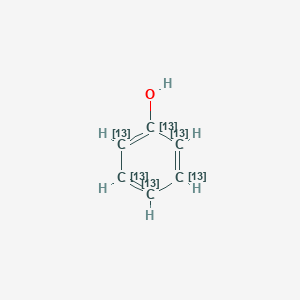
![3,3-Dimethylhexahydro-1H-pyrrolo[1,2-c]imidazol-1-one](/img/structure/B127449.png)
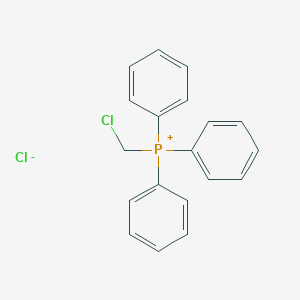
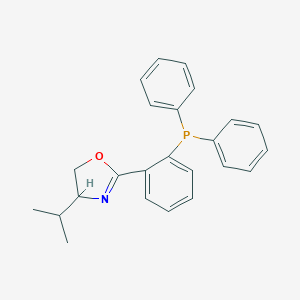
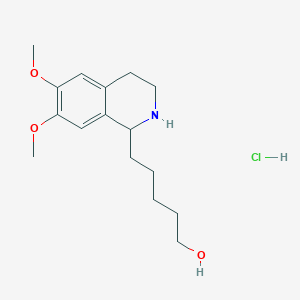
![4'-(Bromomethyl)-[1,1'-biphenyl]-2-carboxamide](/img/structure/B127465.png)
![4'-(Bromomethyl)-[1,1'-biphenyl]-2-carboxylic acid](/img/structure/B127467.png)
![[2-(2-Amino-phenyl)-2-oxo-ethyl]-carbamic acid tert-butyl ester](/img/structure/B127468.png)
![1-N,3-N-bis(2,3-dihydroxypropyl)-5-[2-(2-hydroxyethylamino)-2-oxoethoxy]-2,4,6-triiodobenzene-1,3-dicarboxamide](/img/structure/B127472.png)

